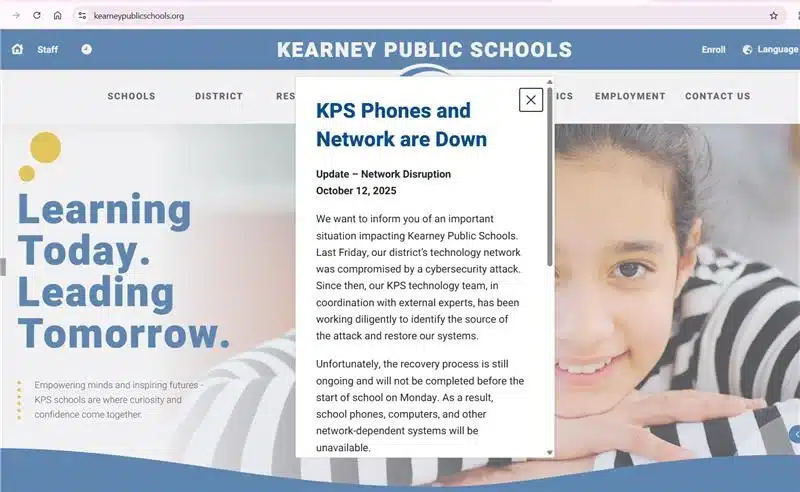Kearney Public Schools Faces Cybersecurity Crisis
Kearney Public Schools (KPS) is currently grappling with a significant cybersecurity incident that has severely impacted its entire technology infrastructure, obstructing communication systems, including phones and computers, throughout the district. This cyberattack, which transpired last Friday, has left the school’s digital communication channels inoperable as students and staff prepare to return to classes on Monday.
Incident Overview
In an official statement, KPS confirmed that its technology systems had been compromised by a cybersecurity breach, leading to an ongoing investigation and recovery efforts in collaboration with external cybersecurity professionals. Despite the disruption, the district has reassured parents and students that classes will proceed as planned.
“Phones and email will not be operational,” the statement detailed. “If you need to contact the school, please do so in person. Instruction will continue, but digital tools cannot be utilized until the network is fully restored.” The district emphasized that the safety of students, staff, and all relevant data remains its foremost concern. Although specifics about the nature or origin of the cyberattack remain undisclosed, officials anticipate that recovery efforts may extend over the next few days.
A Growing Trend: Cyberattacks in Education
The attack on KPS is not an isolated incident but rather part of a broader trend of increasing cyber threats targeting educational institutions. A recent survey conducted by the UK government revealed a worrying statistic: educational organizations are now more susceptible to cyberattacks and data breaches than the private sector. The report indicated that nearly 60% of secondary schools had encountered an attack over the past year, while this figure escalated to 80% for further education colleges and 90% for universities.
In stark contrast, only 40% of businesses faced similar breaches during the same timeframe. Even primary schools are not immune, signifying that the educational sector has become a major focus for cybercriminals.
Insider Threats and Student Involvement
Compounding the issue, insider threats are emerging as a considerable challenge for schools. Another study found that over half of cyber incidents within the education sector resulted from insider actions, with students accounting for 57% of the attacks. Alarmingly, nearly one-third of these breaches occurred because students to guess weak passwords or stumbled upon login credentials that were carelessly written down.
“Teen hackers are not breaking in — they’re logging in,” warned the report, highlighting that curiosity and ease of access significantly contribute to this growing issue. The National Crime Agency (NCA) has echoed these concerns, noting that one in five children aged 10 to 16 has participated in illicit online activities. The youngest individual referred to the NCA’s Cyber Choices program aimed at guiding youth toward ethical cyber practices was merely seven years old.
Recurrent Cyber Threats in North America
The cybersecurity breach affecting Kearney Public Schools comes on the heels of multiple high-profile attacks targeting educational institutions in North America throughout the year. For instance, in July 2025, the Toronto District School Board (TDSB) reported an extortion attempt following a significant data breach involving the education software provider PowerSchool. Similarly, in January, the Harrison County Board of Education in the U.S. experienced a cybersecurity issue that led to unauthorized system access, necessitating a temporary network shutdown.
As KPS works diligently to restore normalcy, cybersecurity experts stress the critical need for awareness and robust password practices within schools. This incident acts as a poignant reminder that in today’s digital learning environments, even young students can unwittingly, or at times knowingly, create significant cyber vulnerabilities.
Kearney Public Schools has committed to keeping the community informed as more details emerge and systems are gradually brought back online.




